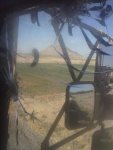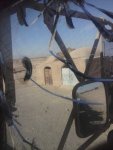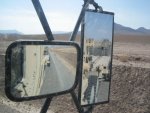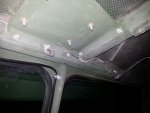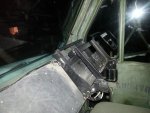HETvet
Member
- 395
- 7
- 18
- Location
- Bedford, texas
Power and mileage
In stock form, the engine is detuned in military applications. Again, this is also where the DDEC computer is valuable. With those unlock keys and codes, the user can get in to things such as fuel pressure and cut off values, requested boost, speed limiter/governor, and fuel tank pressure timing as well as other tables and parameters. Remember my trucks motor had to be pulled? After it was re-installed, I had a civilian friend of mine who had this information and equipment get in to my trucks computer. I was driving the full system wide open, with a combat loaded M1A1 loaded, and was easily pulling past 65 mph. Also having this equipment will allow the owner to "tune", if you will, for modifications that are installed.
So, you say you want power? How crazy do you want to get and how deep are your pockets?
The air box retains quite a bit of heat. What I have done is remove the induction system from the turbo out off the truck. After de-greasing and thoroughly cleaning inside and out side of the parts, I wrapped the turbo mouth piece in a aluminized fire blanket and secured it with safety wire. For the air box, I covered the out side of it with about 10 layers of aluminum tape. From what the DDEC showed for IAT before and after was about a 20-30 degree drop in IATs. For the civilian owner, I would recommend coating both with lizard skin thermal coating or something similar. The sealing rubber flaps that are on the air box (they make contact with the hood), I would also remove and replace with something a little more sturdy and can create a better seal against the hood.
The exhaust manifolds work quite well, along with the crossover pipes. To improve turbo spool up time, I would wrap the manifolds and the crossover pipes in exhaust wrap/thermal wrap. A secondary, and nice improvement in doing this is reduced under hood temperatures. If you like to tinker and what sort, you can remove the manifold and port them and smooth out the in side of them. The total amount of material you can remove is about an 1/8 of an inch. And cause they are cast, smoothing out the inside is going to help flow and speed up velocity some. You could also do some port matching on the head, but I honestly don't see much, if any improvement being had there. Under the passenger side of the cab, behind what looks like a cage or shield, is the muffler. Ditch it and replace with a straight pipe. Doing this will help lower EGTs and increase turbo spool up time. Its also worth mentioning that replacing the inducer wheel, if yours is worn, is also going to bump up the power some.
The injection pump is a mechanical unit. Its worth it to have it re-built or get a new one. JP-8 is a very poor quality fuel and a low BTU potential and zero lubricity properties. With mechanical style injection pumps, they are dependent on the lubrication that the fuel provides for efficient and smooth operation. That being said, it stands to reason that after years of JP-8 use, the injection pump is due for a rebuild. If you decide to go the route of getting a new one, I recommend getting the 8V92TA pump. This pump can provide more fuel volume. The injectors on the motor are the smallest, in terms of orifice size and injection quantity, of all the injectors used in any of the 92 series motors. For the same reasons for the injection pump replacement, its strongly recommended to rebuild, or preferably, replace the injectors. The 8V92TA injectors inject up to 20% more fuel than the injectors that currently are on the motor.
After doing all the above modifications, whether rebuilt parts or the TA new parts, use the DDEC to unlock the fuel tables. In there you should increase the requested fuel pressure by 10-20% of the current value (for re-built parts), or 10% below the max allowable pressure for the TA fuel parts. While in the fuel tables, move the fuel cut off up. CAUTION: by doing this, your doing step 1 of 2 in the process of raising or eliminating the rev-limiter. Its on you and you alone if you blow your motor up from over revving it. Depending upon what version of DDEC you have and the motor has (they must be the same or else they will not communicate) you can also go in and adjust injection quantity. Of the 2 injectors I have mentioned, the TA injectors will naturally flow and inject more fuel. In ether case, a safe upper limit of 70% of the max injection quantity is about all you are going to want to do. CAUTION: Its on you if you fry your injectors or do catastrophic damage to any parts of the engine including, but not limited to, the turbo, pistons, or connecting rods from to high of EGTs or other problems that associate with injecting to much fuel or exceeding the capabilities for the fuel system components.
In doing the above stated modifications, the end user will see up to about an 8% increase in fuel mileage, as long as the operator can restrain his or her right foot. These modifications will also increase the power out put significantly. To my knowledge, no one has put a HET on a dyno, much less a before and after comparison of these, or similar modifications. But I can assure you, the new found power can be felt and experienced, especially when loaded.
For those looking for a max effort build, every component besides for the block and water pump should be installed from the 8V92TA. The 8V92TA is the marine application engine. Currently used in tug boats and mid sized luxury crafts, this engine has a lower compression ratio, significantly larger valves, a larger supercharger and twin turbo system; besides for the fuel components that were mentioned above. A completely custom air intake system is needed as each turbo has its own air filter and subsequent induction tubes. The same modifications as above should be performed in regards to the air intake system and the exhaust system and thermal insulation. A full porting and polishing of the exhaust ports, and port matching to the manifolds (in conjunction to a more radical manifold porting) should be conducted for maximum flow and volume. The intake ports should also get treated to a port job as well as swirl polishing. Swirl polishing is a method of smoothing the intake ports of the head, but promotes the incoming air to spin, or swirl, for increased fuel atomization properties. A completely custom exhaust system from the turbo(s) back will need to be fabricated. I would go no smaller than a 4 inch pipe off the turbo. After they merge, nothing less than 6 inch pipes should be used. The factory 8V92TA is rated up to 750 horse power. for comparison, the HETs 8V92 is rated at no more than 500-ish horse power.
In terms of the transmission, there is not a lot you can do. The cover over the dash, where the heater controls are located, along where the PTO, gas particulate filter, and chemical alarm switches are can be removed using a Philips head screw driver. Its held on by 6-8 screws. Down in side there are 2 nobs, they resemble the nobs that are on your water spicket for your garden hose. One will be higher in relation to the other. These adjust the air pressure going to the transmission and the transfer case. I cant remember what one controls what part. The transfer case nob adjust the air pressure when engaging and holding the selected range in the transfer case. The other one adjusts the air pressure going to the transmission for controlling line pressure, thus shift firmness and holding/clamping force applied by or on the clutches and bands. ADJUST AT YOUR OWN RISK! messing ether of these adjustments up will result in drive line component failure. A worth while modification is fixing any leaking transmission lines and fittings. if the lines are not braided stainless steel lines, now would be a good time to replace them. Installing a larger transmission cooler comes highly recommended. I have seen these things get north of 240 degrees with out trying to hard! Another reason for switching to full synthetic. As long at the transmission shifts as I described previously, I would leave it be with the addition of the braided lines and larger cooler.
In terms of system cooling, this thing gets hot with out trying. First thing I would do is thoroughly clean the radiator to ensure as much air can flow through it as possible. If its not known when the coolant was last changed, and it most likely never has, I would flush it and give it fresh coolant and a fresh coolant filter. Check to see if the upper coolant hose is not in contact with the turbo crossover pipe. This is a 50% possibility and doesn't take long to fix; trim the hose. Also fixing any leaking oil lines should be done. As with the transmission lines, if they are not steel braided lines, replace them for the steel braided lines at this time. Ether installing an oil cooler, or installing a larger oil cooler is also highly recommended. With the hood raised, you will see a black rubber sealer type thing on ether side of the radiator. Its intended function is to keep air flowing through the radiator as apposed to around it. It fails at doing its job. Installing a better sealing rubber that will have more contact with the hood is a good start. There still is a decent gap between the radiator and the mounting frame of this rubber thing. Filling this gap on ether side should force air through the radiator. What we have used for this is cutting and bending a thin piece of sheet aluminum and using some nuts and bolts to secure it. At the bottom of the hood sides, where the fenders are when the hood is down, there is a piece of rubber that seals the hood to the top of the fender. Its only purpose is to dampen hood vibrations. You can unbolt it from the hood, I just cut it off flush with the hood. Doing this increases air flow in to the engine compartment, lowering under hood temps.
The next topic will be everything I know and have done to make things more comfortable and user friendly. Stay tuned
In stock form, the engine is detuned in military applications. Again, this is also where the DDEC computer is valuable. With those unlock keys and codes, the user can get in to things such as fuel pressure and cut off values, requested boost, speed limiter/governor, and fuel tank pressure timing as well as other tables and parameters. Remember my trucks motor had to be pulled? After it was re-installed, I had a civilian friend of mine who had this information and equipment get in to my trucks computer. I was driving the full system wide open, with a combat loaded M1A1 loaded, and was easily pulling past 65 mph. Also having this equipment will allow the owner to "tune", if you will, for modifications that are installed.
So, you say you want power? How crazy do you want to get and how deep are your pockets?
The air box retains quite a bit of heat. What I have done is remove the induction system from the turbo out off the truck. After de-greasing and thoroughly cleaning inside and out side of the parts, I wrapped the turbo mouth piece in a aluminized fire blanket and secured it with safety wire. For the air box, I covered the out side of it with about 10 layers of aluminum tape. From what the DDEC showed for IAT before and after was about a 20-30 degree drop in IATs. For the civilian owner, I would recommend coating both with lizard skin thermal coating or something similar. The sealing rubber flaps that are on the air box (they make contact with the hood), I would also remove and replace with something a little more sturdy and can create a better seal against the hood.
The exhaust manifolds work quite well, along with the crossover pipes. To improve turbo spool up time, I would wrap the manifolds and the crossover pipes in exhaust wrap/thermal wrap. A secondary, and nice improvement in doing this is reduced under hood temperatures. If you like to tinker and what sort, you can remove the manifold and port them and smooth out the in side of them. The total amount of material you can remove is about an 1/8 of an inch. And cause they are cast, smoothing out the inside is going to help flow and speed up velocity some. You could also do some port matching on the head, but I honestly don't see much, if any improvement being had there. Under the passenger side of the cab, behind what looks like a cage or shield, is the muffler. Ditch it and replace with a straight pipe. Doing this will help lower EGTs and increase turbo spool up time. Its also worth mentioning that replacing the inducer wheel, if yours is worn, is also going to bump up the power some.
The injection pump is a mechanical unit. Its worth it to have it re-built or get a new one. JP-8 is a very poor quality fuel and a low BTU potential and zero lubricity properties. With mechanical style injection pumps, they are dependent on the lubrication that the fuel provides for efficient and smooth operation. That being said, it stands to reason that after years of JP-8 use, the injection pump is due for a rebuild. If you decide to go the route of getting a new one, I recommend getting the 8V92TA pump. This pump can provide more fuel volume. The injectors on the motor are the smallest, in terms of orifice size and injection quantity, of all the injectors used in any of the 92 series motors. For the same reasons for the injection pump replacement, its strongly recommended to rebuild, or preferably, replace the injectors. The 8V92TA injectors inject up to 20% more fuel than the injectors that currently are on the motor.
After doing all the above modifications, whether rebuilt parts or the TA new parts, use the DDEC to unlock the fuel tables. In there you should increase the requested fuel pressure by 10-20% of the current value (for re-built parts), or 10% below the max allowable pressure for the TA fuel parts. While in the fuel tables, move the fuel cut off up. CAUTION: by doing this, your doing step 1 of 2 in the process of raising or eliminating the rev-limiter. Its on you and you alone if you blow your motor up from over revving it. Depending upon what version of DDEC you have and the motor has (they must be the same or else they will not communicate) you can also go in and adjust injection quantity. Of the 2 injectors I have mentioned, the TA injectors will naturally flow and inject more fuel. In ether case, a safe upper limit of 70% of the max injection quantity is about all you are going to want to do. CAUTION: Its on you if you fry your injectors or do catastrophic damage to any parts of the engine including, but not limited to, the turbo, pistons, or connecting rods from to high of EGTs or other problems that associate with injecting to much fuel or exceeding the capabilities for the fuel system components.
In doing the above stated modifications, the end user will see up to about an 8% increase in fuel mileage, as long as the operator can restrain his or her right foot. These modifications will also increase the power out put significantly. To my knowledge, no one has put a HET on a dyno, much less a before and after comparison of these, or similar modifications. But I can assure you, the new found power can be felt and experienced, especially when loaded.
For those looking for a max effort build, every component besides for the block and water pump should be installed from the 8V92TA. The 8V92TA is the marine application engine. Currently used in tug boats and mid sized luxury crafts, this engine has a lower compression ratio, significantly larger valves, a larger supercharger and twin turbo system; besides for the fuel components that were mentioned above. A completely custom air intake system is needed as each turbo has its own air filter and subsequent induction tubes. The same modifications as above should be performed in regards to the air intake system and the exhaust system and thermal insulation. A full porting and polishing of the exhaust ports, and port matching to the manifolds (in conjunction to a more radical manifold porting) should be conducted for maximum flow and volume. The intake ports should also get treated to a port job as well as swirl polishing. Swirl polishing is a method of smoothing the intake ports of the head, but promotes the incoming air to spin, or swirl, for increased fuel atomization properties. A completely custom exhaust system from the turbo(s) back will need to be fabricated. I would go no smaller than a 4 inch pipe off the turbo. After they merge, nothing less than 6 inch pipes should be used. The factory 8V92TA is rated up to 750 horse power. for comparison, the HETs 8V92 is rated at no more than 500-ish horse power.
In terms of the transmission, there is not a lot you can do. The cover over the dash, where the heater controls are located, along where the PTO, gas particulate filter, and chemical alarm switches are can be removed using a Philips head screw driver. Its held on by 6-8 screws. Down in side there are 2 nobs, they resemble the nobs that are on your water spicket for your garden hose. One will be higher in relation to the other. These adjust the air pressure going to the transmission and the transfer case. I cant remember what one controls what part. The transfer case nob adjust the air pressure when engaging and holding the selected range in the transfer case. The other one adjusts the air pressure going to the transmission for controlling line pressure, thus shift firmness and holding/clamping force applied by or on the clutches and bands. ADJUST AT YOUR OWN RISK! messing ether of these adjustments up will result in drive line component failure. A worth while modification is fixing any leaking transmission lines and fittings. if the lines are not braided stainless steel lines, now would be a good time to replace them. Installing a larger transmission cooler comes highly recommended. I have seen these things get north of 240 degrees with out trying to hard! Another reason for switching to full synthetic. As long at the transmission shifts as I described previously, I would leave it be with the addition of the braided lines and larger cooler.
In terms of system cooling, this thing gets hot with out trying. First thing I would do is thoroughly clean the radiator to ensure as much air can flow through it as possible. If its not known when the coolant was last changed, and it most likely never has, I would flush it and give it fresh coolant and a fresh coolant filter. Check to see if the upper coolant hose is not in contact with the turbo crossover pipe. This is a 50% possibility and doesn't take long to fix; trim the hose. Also fixing any leaking oil lines should be done. As with the transmission lines, if they are not steel braided lines, replace them for the steel braided lines at this time. Ether installing an oil cooler, or installing a larger oil cooler is also highly recommended. With the hood raised, you will see a black rubber sealer type thing on ether side of the radiator. Its intended function is to keep air flowing through the radiator as apposed to around it. It fails at doing its job. Installing a better sealing rubber that will have more contact with the hood is a good start. There still is a decent gap between the radiator and the mounting frame of this rubber thing. Filling this gap on ether side should force air through the radiator. What we have used for this is cutting and bending a thin piece of sheet aluminum and using some nuts and bolts to secure it. At the bottom of the hood sides, where the fenders are when the hood is down, there is a piece of rubber that seals the hood to the top of the fender. Its only purpose is to dampen hood vibrations. You can unbolt it from the hood, I just cut it off flush with the hood. Doing this increases air flow in to the engine compartment, lowering under hood temps.
The next topic will be everything I know and have done to make things more comfortable and user friendly. Stay tuned
Last edited by a moderator:



